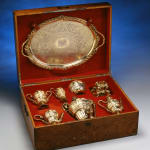Jean-Baptiste-Gustave Odiot
Provenance
Count Cesar Trezza de Mussella, Verona, Italy who ordered this service in June 1892.
Literature
Henri Bouillet, "Musée Rétrospectif de la classe 94: l'Orfèvrerie Française à l'Exposition Universelle Internationale de 1900, à Paris. Livre deuxième, Le dix-neuvième siècle deuxième période 1860-1900: Rapport du Comité d'Installation", 1912, p. 232, illustrating an identical service exhibited at the Paris Exposition Universelle of 1867, of which it was noted "Of the works executed by this artist, we cannot omit to mention the pretty tea service, modelled in the Louis XVI style, exhibited by Odiot at the 1867 exhibition, and which we came across there. It gives a precise measure of the considerable skills possessed by Diomède in the handling of the chasing."
A magnificent Louis XVI Style solid silver-gilt seven-piece tea and coffee service by Jean-Baptiste-Gustave Odiot, designed and modelled by François Gilbert and chased by Paul Diomède each piece fully hallmarked, comprising a silver-gilt teapot, coffee pot, hot water urn with detachable stand, sugar bowl, milk jug, coupe and tray enclosing at centre the coat of arms belonging to Cesar Trezza de Mussella of Verona, housed in its original velvet-lined oak box stamped above the middle hinge Odiot Orfèvrerie à Paris, The teapot, coffee pot, sugar bowl and urn each with a part-fluted domed top surmounted by a flowering and fruiting finial above scrolled foliate handles and an ovoid body chased around its upper half with reclining semi-nude classical maidens and putti, the lower fluted half of each body above a spreading stem on monopodia legs with hoof feet. The milk jug of similar form and like the circular coupe, chased with the same figures. The oval-shaped tray engraved overall with floral arabesques and with conjoined fruiting cornucopia handles
Weight 30 kilos
Paris, date circa 1892
This magnificent service by Odiot à Paris is a replica of one of the firm's showpieces at the Paris Universal Exhibition of 1867, which had been modelled by the sculptor François Gilbert (1816-1891) and chased and engraved by Paul Diomède. At the time of its creation, this highly important silversmithing firm was being run by Jean-Baptiste-Gustave Odiot (1823-1912), grandson of the firm's founder Jean-Baptiste Claude Odiot (1763-1850). The service was specifically commissioned by Count Cesar Trezza de Mussella who served as president of the Italian Chamber of Commerce in Paris and interestingly was married in London in the same year that he ordered this service from Odiot.
JEAN-BAPTISTE-GUSTAVE ODIOT (1823 - 1912), FRENCH
Since the beginning of the Eighteenth Century the Odiot family have distinguished themselves at master silversmiths. The best known of this dynasty was Jean-Baptiste-Gustave's grandfather, Jean-Baptiste-Claude Odiot (1763-1850) who created some of the finest Empire silver. Heavily patronised by Napoleon and later Louis XVIII he also furnished services to a number of other European courts. On his retirement. 1827 the business passed to his elder son, Charles-Nicolas (1789-1868) upon whose death the firm was entrusted to his elder son, Jean-Baptiste-Gustave (referred to as Gustave). Charles-Nicolas developed a softer and less austere rendition of his father's Empire style, introducing cherubs, floral swags and flowing vines His style reflected the renewed interest for the rococo which was to be more fully exploited by his son, Gustave. Gustave also applied Louis XVI and Renaissance forms and decorations.
Such a variety of styles exemplified the eclecticism during the Second Empire, in addition Gustave often combined more then one style to create a unique design. For example his grandfather developed the Antique motif using a female figure to support a vessel. Gustave also used this theme to good effect, but for instance, replaced the Empire sphinx with a cherub. In 1859 he created a centre piece for the Duc l' Aumale (Odiot collection), comprising three cherubs holding a boat shaped vase. In another piece, a silver-gilt tureen of 1880 [private collection) the dish is supported by a semi-draped crouching nude; this tureen was designed by Edouard Récipon. who often collaborated with Gustave.
On occassion Gustave worked with his father and from the 1860's poduced a number of pieces in the Chinese style.The taste for Chinoiserie was immensely popular during the early Eighteenth Century under rococo influence and enjoyed a revival during the mid Nineteenth Century. Charles-Nicolas and Gustave were also influenced by Japan, in particular they imitated Far Eastern Metalwork techniques, sometimes producing a matt finish by the use of acids and decorating their silver with etched floral panels. Gustave produced a fine bougeoir de toilette, 1883 (Odiot collection), inspired by the French rococo silversmith, Thomas Germain (1673-1748). Here Gustave uses shell-shaped dishes and naturalist asymmetrical stems to create candlesticks. Other pieces by him look back to the Louis XVI style, so favoured by Napoléon Ill's Empress, Eugénie. At the Exposition Universelle. Paris, 1867, Gustave showed a Louis XVI style silver-gilt jardinière, with handles formed of semi-nude classical maidens. At other times Gustave looked back to the Renaissance, for example his design for a silver-gilt dessert knife and fork with porcelain handles, 1890 (Odiot collection) is modelled after the Renaissance, though the decoration to the handles is ostensibly Chinese. Interestingly the mixture of materials in cutlery was still relatively new in 1890 and demonstrates Gustave's flair for innovation. Gustave was a superb craftsman, appreciated at home and abroad: in 1898 he received an appointment with the Russian court. Today however his name tends to be overshadowed by his grandfather but in the light of an important and recent biography on the Odiot Family (by J-M.Pincon and O. Gaube du Gers, 1990) Gustave's importance has been reassured.
Copyright by Richard Redding Ltd.



